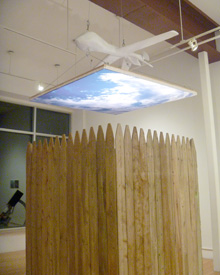
‘BLUE SKIES’ Mixed media installation, 48 by
48 by 180 inches, by Jeff Badger, 2013. |
The protagonist of Thomas Pynchon’s classic comic novel Gravity’s Rainbow, Tyrone Slothrop, often puzzles over “non-reversible behavior,” his subjective experience of universal entropy in a time of vast danger. An apparently inverse causal relationship between V-2 rocket attacks and his love life forms the background of a long, funny, and paranoid tale.
Thoughts like this come to mind in “OK Back OK,” Jeff Badger’s show at Rose Contemporary in Portland, filled as it is with pictures of scenes in which things have either gone very wrong or are about to, seen through both the lens of our human perception of time’s arrow and the modern computerized ability to go back and change, to undo and redo. In the time of Pynchon’s novel, published in the 1970s and set in World War II, if you didn’t do it right you had to do it over. But in Pynchon’s world, and in Badger’s, to say nothing of modern cosmological understanding, time is flexible and effects are not as attached to causes as we might wish.
The show is largely works on paper, and mostly funny and sometimes a little creepy, and often both. One of larger works has little humor I could detect, but more of that later. When you enter Badger’s world you know that safety is mutable, and probably for reasons that are not only unforeseeable but that are only marginally sane. Which means that the ideas presented are, in these unfathomable times, realistic.
A good example is a small work on paper, “Pink Streak.” In a suburban housing development, the eponymous streak has emerged from a school or factory, coursed through the neighborhood damaging or entirely destroying houses and then disappeared into the sea in the distance. Or maybe it has come from the sea and traveled in the other direction. Or maybe it’s not the track of some animal or machine but is instead itself an unknown, and unknowable, dangerous artifact. Badger gives us few clues about causes in his world, focusing instead on effects.
In a couple of other works a giant fish has landed in the dooryard of an ordinary suburban house. It’s a primitive-looking specimen, not unlike the odd, cod-sized cusk, except that is twice as long as the house is wide. It is apparently still alive. House and fish are encircled by orange stay-away tape, sawhorses, and traffic cones, as if it were as normal an occurrence as, say, an extra-deep pothole. How the fish might have got there is unclear, but there is very little damage other than its unaccountable presence.
One particularly engaging work tunnels through the clouds of knowing and unknowing that are a fundamental characteristic of 21st-century life back toward an apparently easier time. “Black Thoughts” is constructed on a real school desk for a very young student in the days of one-room schoolhouses. From a small distance an object on the desk appears to be a crumpled piece of white notebook paper that has been infested with worms. A closer look shows that the worms are actually little yellow sharpened pencils complete with erasers that are doing worm things: moving around like an inchworm, crawling in and out of the paper. The worms seem, as small worms do, benign, but maybe not. At least no one is playing pinochle (do kids still sing that song?).